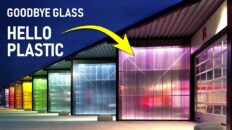Aerogel is the world’s lightest solid. Around 99.8% of this material is air making it an excellent insulator. Aspen Aerogels embedded tiny particles of aerogel into fibers to create flexible insulation blankets for buildings. This material is 5 times better than standard insulation. So, how does this fascinating material work? Can we use this to build super insulated structures to cut down our energy bills?
Introduction
Aerogels are solid gels with pockets of air, earning them the nickname “frozen smoke” due to their translucent appearance. The primary ingredient in silica aerogel is tetramethyl orthosilicate (TMOS), combined with methanol, deionized water, and ammonium hydroxide as a catalyst. This unique composition results in a lightweight, elastic, and highly insulating material.
To make aerogel more resilient and versatile for the construction industry, tiny silica aerogel particles are embedded into a flexible fabric made of polyester and glass fibers. This creates a Spaceloft Insulation blanket. These fibers are also called a non-woven batting material. They are bonded together with the help of heat, pressure or chemical binders. They provide a flexible and durable support for aerogel particles, and turn a fragile material into a useful product.
Aerogel insulation blankets are sold in 2 thicknesses; 5mm and 10mm. It’s stiff, but pliable. It can be cut on site or in a factory with scissors or razor snips and it can be easily shaped to fit around pipes, ducts, wires, and other irregular surfaces. It gives off a very slight smell of ammonia and it leaves your fingers feeling powdery and dry, but it is not toxic in small quantities.
Advantages
- Superior Insulating Power: With an impressive R-value of 10.3 per inch, aerogel outperforms traditional insulators like fiberglass, Rockwool, and XPS insulation. Its ability to slow down heat transfer and eliminate thermal bridging leads to significant energy savings in buildings.
- Versatility: Spaceloft, offer a thin, space-saving profile and can be easily shaped to fit around pipes, wires, and irregular surfaces. It is compatible with various building materials, making it suitable for a wide range of applications.
- Fire Resistance: Aerogel insulation possesses a Class A fire rating, making it a safe choice for construction. It can withstand temperatures from -200 Celsius of -390 Fahrenheit to 200 Celsius or 390 Fahrenheit.
- Breathability: Vapor-open properties allow water vapor to pass through. It is ideal for use in historic buildings and environments where moisture control is crucial.
- Water repelling: Spaceloft aerogel blankets are treated with special compounds to make them superhydrophobic or water-repelling.
Uses
It has been used on curved staircases, on historic old mills in Switzerland, a multi-family house, a church, country house and more. Of course, like every building material and system, it has some disadvantages.

Disadvantages
- Fragile Nature: Pure aerogel is brittle and easily crumbles, limiting its applications. However, embedding aerogel particles into a flexible fabric enhances its durability and utility for construction purposes.
- Dustiness: Working with aerogel insulation can generate silica dust, which may cause throat and lung irritation if inhaled. Proper safety gear, such as gloves, eye protection, and a dust mask, is essential during installation.
- Cost: The primary hurdle to mass adoption is the higher cost of aerogel insulation compared to traditional alternatives. In general, it costs around $7 to $20 per sqft more expensive than Rockwool which costs around $2 per sqft. However, ongoing research and innovations are aimed at reducing the cost.
Conclusion
Aerogel insulation stands as a remarkable advancement in the field of energy-efficient construction. Its unparalleled thermal performance, fire resistance, and breathability make it perfect for specialized projects, historic renovations, and industrial applications. While the current cost may limit its widespread use, ongoing advancements in aerogel technology hold promise for a more sustainable and energy-efficient future in construction.





